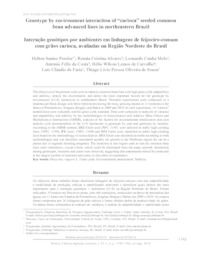Genotype by environment interaction of "carioca" seeded common bean advanced lines in northeastern Brazil.
Genotype by environment interaction of "carioca" seeded common bean advanced lines in northeastern Brazil.
Autoria: PEREIRA, H. S.; ALVARES, R. C.; MELO, L. C.; COSTA, A. F. da; CARVALHO, H. W. L. de; FARIA, L. C. de; SOUZA, T. L. P. O. de
Resumo: The objectives of the present work were to identify common bean lines with high grain yield, adaptability and stability; stratify the environment; and detect the most important factors for the genotype by environment (GxE) interaction in northeastern Brazil. Nineteen experiments were conducted in a randomized block design with three replications during the rainy growing season at 11 locations in the States of Pernambuco, Alagoas, Sergipe, and Bahia in 2009 and 2010. In each experiment, 16 "carioca" seeded lines were evaluated, and the grain yield, assessed. Data were subjected to analyses of variance and adaptability and stability by the methodologies of Annicchiarico and Additive Main Effects and Multiplicative Interactions (AMMI), analysis of the factors for environmental stratification and joint analysis with decomposition of the GxE interaction in genotype by year and genotype by location. According to the AMMI method, BRS Estilo and CNFC 11951 were selected as stable high-yielding lines. CNFC 11954, IPR Juriti, CNFC 11948 and BRS Estilo were identified as stable high-yielding lines based on the methodology of Annicchiarico. BRS Estilo was identified as stable according to both methodologies and was therefore considered suitable for growth in the Northeast region for use as a parent line in regional breeding programs. The locations in this region used to test the common bean lines were informative, except Carira, which could be eliminated from the assay network. Interaction among genotypes, locations and years were observed, suggesting that assessments shoud be conducted at the largest number of locations and years, in this order of importance.
Ano de publicação: 2016
Tipo de publicação: Artigo de periódico
Unidade: Embrapa Arroz e Feijão
Observações
1 - Por padrão são exibidas publicações dos últimos 20 anos. Para encontrar publicações mais antigas, configure o filtro ano de publicação, colocando o ano a partir do qual você deseja encontrar publicações. O filtro está na coluna da esquerda na busca acima.
2 - Para ler algumas publicações da Embrapa (apenas as que estão em formato ePub), é necessário ter, no celular ou computador, um desses softwares gratuitos. Sistemas Android: Google Play Livros; IOS: iBooks; Windows e Linux: software Calibre.
Acesse outras publicações
Acesse a Base de Dados da Pesquisa Agropecuária (BDPA) para consultar o acervo completo das bibliotecas da Embrapa.

